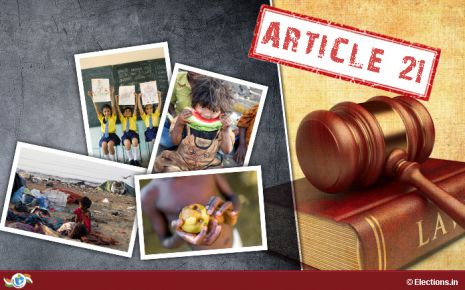Female Genital Mutilation: A Tradition or Brutality?
Philomena, a seven-year-old Kenyan was overjoyed when she was told that she
would be attending school with her brother. Philomena's mother, a few months
later, told her that they were going to do something special. Philomena got very
excited but to her surprise, she was given a scare which would be with her for
the whole life.
Her mother took her for a brutal and painful procedure which was a 'tradition' in their community and every girl of Philomena's age has to go through it. Philomena was cut between her legs, while her mother and grandmother held her limbs. She passed out. When she woke up, she found her legs tied up closely to stop the bleeding.
This is not the story of one girl but about a horrific custom that is followed in many parts of the world in the name of culture and tradition. The process does not have any health benefits but still many girls under the age of 18 goes through it. Female Genital Mutilation is an unethical and a painful procedure of removing completely or partially the external genitals of girls. The practice has both physical and mental impact on the victims.
This could also lead to death of the person. However, many communities continue to follow it. Globally, it is a violation of human right and is also against the idea of utilitarianism. It is the need of the hour that nations realise the ill-effects of this practice and pass legislations to stop this brutality.
Introduction
Numerous United Nation assessments have found that the procedure of Female Genital Mutilation is mostly prevalent in African and Middle Eastern nations. Certain Asian and Latin American also carries out this harmful procedure on the women residing there. Sadly, India is also one of the nations which is still following this immoral tradition. 26 out of 29 countries in Africa and the Middle East have passed certain legislations to curb the practice, however it is still a long way to go to demolish this practice from its roots.
Female Genital Mutilation refers to the practice which includes all the procedures of partially or totally removing the external genitals, or the other injuries caused to remove the female genital organs for non-medical reasons. Earlier, Female Genital Mutilation was referred to as female circumcision and was considered to be similar to the process of male circumcision. However, in practice, both the procedures are very different.
In male circumcision, only a part of the foreskin of the penis is removed without impairing its sexual function. Thus, it was necessary to change the term 'female circumcision' to 'female genital mutilation' to define the procedure more accurately. The females who have undergone this process were used to be called as 'mutilated' regarding which they protested as the term highlighted the long-term trauma suffered by the victims. Therefore, in order to respect the feelings of the victims, 'female genital mutilation' is also called 'female genital cutting.' [1]
World Health Organization (WHO) has classified Female Genital Mutilation into four different types. These are as follow:
There are various sociocultural factors that results into the practice of FGM from one region to the other and within various families and communities. One of the main factors which manifests the practice is entrenched gender inequality and societal acceptance. Some cultures support it as a means of restraining in girls' sensuality or protecting their purity. Others make it mandatory for girls to undergo FGM as a condition of marriage or inheritance.
Where it is most common, civilizations frequently regard it as a rite of passage for young women. Islam and Christianity do not endorse FGM, but religious narratives are commonly used to justify the same. Since FGM is a social tradition, parents may find it difficult to refuse to have their daughters undergo the procedure for fear of their family being shunned or their daughters deemed not eligible for marriage.[3]
Where FGM is a social convention (social norm), the social pressure to comply to what others do and have done, as well as the desire to be accepted socially and the fear of rejection by the community, are powerful motivators to continue the practice. FGM is frequently seen as an important part of a girl's upbringing and a way to prepare her for maturity and marriage. FGM is frequently motivated by preconceived notions about what constitutes acceptable sexual behaviour.
Its goal is to ensure marital fidelity and premarital virginity. Religious leaders take a variety of perspectives on FGM: some support it, some believe it is unrelated to religion, and yet others advocate for its abolition. Local power and authority structures, such as civic leaders, religious leaders, circumcisers, and even some health doctors, can all play a role in maintaining the process. They can also be powerful advocates for the abolition of FGM if they are well-informed. FGM is considered a cultural tradition in most societies where it is practised, which is sometimes provided as a reason for its continued practise.
FGM is performed for a variety of reasons by health-care professionals. Here are a few examples:
It is also a very painful treatment with dangerous short and long-term consequences, including death. The hedonic calculus, devised by Act Utilitarian Jeremy Bentham, is a "scientific" process for evaluating which pleasures should be pursued and which sufferings should be avoided. FGM is an example of a type of pain that "should" be avoided. Individuals can use this idea to give good arguments for their actions. Bentham thinks that we must always account for the joys and sufferings while deciding what is the proper thing to do.
Some pleasures and sufferings are more intense than others, according to the hedonic calculus and the principle of intensity. Girls and women in this culture are subjected to excruciatingly painful experiences for no good reason.
The practise is carried out in the villages by midwives or elderly "experienced" women who lack medical training and are not educated in the field of medicine. FGM is not simply a risky procedure, but it also has physical, sexual, and psychological effects.
FGM is a dangerous and un-sterile treatment meted on women in numbers of nations across the world. This treatment causes pain and suffering, which goes against Utilitarianism's tenet of highest happiness.
These girls could face a lifetime of misery and suffering as a result of this treatment, depending on the type of procedure and how it is performed. According to research, an estimated 135 million girls and women have had FGM, with an additional 2 million girls at danger each year.
This equates to almost 6,000 girls per day. Returning to the hedonic calculus, the magnitude of misery and suffering inflicted on this culture's girls and women is astonishing, and the numbers are overwhelming. Some cultural relativists may claim that ethical understandings differ throughout cultures, and that what is regarded ethically wrong in one society may be completely acceptable in another after reading about FGM and the context in which it is practised.
FGM on the other hand, does not follow Utilitarianism's greatest happiness criterion because it comprises the deliberate infliction of severe pain and suffering, and its consequences can be life-threatening. It is not only a violation of female rights, but it is also a major violation of children's human rights because it is most usually performed on girls ranging in age from birth to puberty. Henceforth, on utilitarian principles, we should eliminate this cultural practise entirely in order to provide the maximum amount of joy for the biggest number of people affected.
One such tradition, which is not mentioned in the holy texts, has also affected the Bohra girls. Those who do so uncritically fail to see the contradiction between the regressive practise and the otherwise progressive community.[6]
Pakistan, Yemen, East Africa, and dispersed areas of America and Australia [vi] are home to the Bohra population. Due to legal steps made against the practise in Australia and the United States, India is unfortunately becoming a centre for FGM. India, on the other hand, continues to ignore the existence of this tradition. For example, in 2017, the WCD Ministry, led by Ms. Maneka Gandhi, said that there was no meaningful data to support the presence of FGM. As a result, there are no laws against FGM.
Sections 319 to 326 of the Indian Penal Code 1860 and Section 3 of the Protection of Children from Sexual Offenses Act, 2012 remain in effect. Furthermore, in terms of precedents, it has been established in the past that "penetration" in the context of sexual offences does not always have to signify complete penetration. In Explanation 1 of Section 375 of the Indian Penal Code, the term 'vagina' includes labia majora. Section 3 of the POCSO Act, read with Explanation 1 of Section 375 of the Indian Penal Code, can embrace FGM. Despite this, the ritual persists unabated and uncontrolled.[7]
Furthermore, Article 15 of the Indian Constitution guarantees that people are protected from discrimination based on their gender, caste, race, place of birth, or religion. FGM is a violation of this Article because it encourages institutional discrimination against girls and women of a specific sect.
Senior barrister Abhishek Manu Singhvi, who represented the Dawoodi Bohra Women for Religious Freedom in a recent plea to ban FGM, contended that the practise is a vital component of the religion and is protected under Articles 25 and 26 of the Constitution of India 1950.[8] The Supreme Court, however, comprised of a constitutional bench including Chief Justice Dipak Misra, Justice AM Khanwilkar and Justice DY Chandrachud, held that "It is violative of Article 21 of the Constitution as it puts the female child to the trauma of female genital mutilation". [9]
Women who have been subjected to this kind of abuse have had problems with their sexual and reproductive health. Women suffer long-term physical problems as a result of this damage. Among the various health concerns are chronic genital infections, chronic reproductive system infections, urinary tract infections, vaginal issues, menstruation problems, HIV, delivery complications, Obstetric Fistula, and perinatal hazards.
The emotional stress brought on by this unbearable pain is far more serious. Post-traumatic stress disorder (PTSD), depression, suicidal thoughts, anxiety disorders, and phobias have all been linked to this technique. And this trauma affects them for the rest of their life, making them unhappy. FGM is immoral and unethical, and it should be made illegal. It must come to an end before more children are sacrificed to this heinous and barbaric behaviour disguised as tradition.
While many African countries still lack legislation to regulate this practise, some have established specific legislation to outlaw FGM. Cameroon, Congo, and Guinea Bissau are some of the African countries that do not have explicit legislation dealing with FGM, yet punitive measures apply. This technique has recently been outlawed in Australia, the United States, and Sudan.
To talk about countries' legal positions on FGM/C, Kenya has made it a crime by passing the Prohibition of FGM Act, 2011, which makes it a crime punishable by up to three years in prison and a fine of up to $2000 USD. The practise of FGM/C has been steadily declining since these laws were enacted in 2011. Kenya, on the other hand, has been unable to stop this practise from spreading across borders. Even though the law outlaws cross-border FGM, Kenyan authorities are unable to assure that this 'culture' is completely eradicated.
Even though FGM is illegal in countries like Mauritania and Liberia, the consequences are limited to abusers of victims under the age of 18, rendering the law ineffective. Furthermore, no explicit laws or penalties exist for these offences. The severity of the penalties is determined on a case-by-case basis. These are few instances of legal positions on FGM from around the world.
Moving on, FGM/C is a violation of human rights as defined by the UDHR's numerous clauses.[10] The right to health, the right to be free of violence, the right to life and physical integrity, and the right to be free of cruel, inhumane, and humiliating treatment have all been violated.
Conclusion
Gender inequality and discrimination against females has been there since ages in the world. It could be in the form of inequal opportunities provided to them as compared to men or depriving them of certain rights in other. However, Female Genital Mutilation is one of the most horrible practices meted out on the females in various community in our society.
The main reason for the same is the discrimination between the male and female members of the society. Certain religion such as Islamism and Christianity has conformed to this practice in the name of protecting the sexual 'purity of the girls'. The practice has no health benefits on the body of the women and is one of the most painful experiences that they go through.
Reports such as that of WHO and others have shown that now also a large number of women go through this procedure in various areas where the elder unprofessional female members conduct the procedure. In India, the tradition still prevails in Bohra community of Mumbai and there are no specific laws against FGM.
There are no specific laws banning the practice but countries like India and other African countries have made it a criminal offence against children with different punishments. Other countries like Kenya have passed legislations banning the same. Thus, FGM is a brutality against human kind which exists in the name of tradition forcing women to undergo a dangerous procedure which could cause them their life and deprive them of their basic human rights.
End-Notes:
Her mother took her for a brutal and painful procedure which was a 'tradition' in their community and every girl of Philomena's age has to go through it. Philomena was cut between her legs, while her mother and grandmother held her limbs. She passed out. When she woke up, she found her legs tied up closely to stop the bleeding.
This is not the story of one girl but about a horrific custom that is followed in many parts of the world in the name of culture and tradition. The process does not have any health benefits but still many girls under the age of 18 goes through it. Female Genital Mutilation is an unethical and a painful procedure of removing completely or partially the external genitals of girls. The practice has both physical and mental impact on the victims.
This could also lead to death of the person. However, many communities continue to follow it. Globally, it is a violation of human right and is also against the idea of utilitarianism. It is the need of the hour that nations realise the ill-effects of this practice and pass legislations to stop this brutality.
Introduction
Numerous United Nation assessments have found that the procedure of Female Genital Mutilation is mostly prevalent in African and Middle Eastern nations. Certain Asian and Latin American also carries out this harmful procedure on the women residing there. Sadly, India is also one of the nations which is still following this immoral tradition. 26 out of 29 countries in Africa and the Middle East have passed certain legislations to curb the practice, however it is still a long way to go to demolish this practice from its roots.
Female Genital Mutilation refers to the practice which includes all the procedures of partially or totally removing the external genitals, or the other injuries caused to remove the female genital organs for non-medical reasons. Earlier, Female Genital Mutilation was referred to as female circumcision and was considered to be similar to the process of male circumcision. However, in practice, both the procedures are very different.
In male circumcision, only a part of the foreskin of the penis is removed without impairing its sexual function. Thus, it was necessary to change the term 'female circumcision' to 'female genital mutilation' to define the procedure more accurately. The females who have undergone this process were used to be called as 'mutilated' regarding which they protested as the term highlighted the long-term trauma suffered by the victims. Therefore, in order to respect the feelings of the victims, 'female genital mutilation' is also called 'female genital cutting.' [1]
World Health Organization (WHO) has classified Female Genital Mutilation into four different types. These are as follow:
Clitorectomy:
This procedure includes removal of the outer and visible part of the clitoris, the most sensitive part of the female genitals (clitoral glans) and/or the surrounding fold skin of clitoris (clitoral hood/prepuce).
Excision:
It is the partial or complete removal of clitoral glans and inner fold of vulva (labia minora), with or without the removal of outer fold of skins of vulva (labia majora).
Infibulation:
It refers to the process of narrowing the vaginal opening by creating a covering seal through cutting and repositioning the labia minora, or labia majora by stitching, with or without the removal of clitoral glans and clitoral hood/prepuce.
- This consists of all other harmful methods used on female genitals for non-medical reasons such as- pricking, piercing, incising, scraping and cauterizing the genital area.[2]
Factors Responsible for Female Genital Mutilation
FGM has widely been recognized as human rights violation, however still it has been carried out on at least 200 million girls and women in 31 countries. More than 4 million girls are at risk of undergoing FGM annually. Girls below the age of 15 years are mostly subjected to this procedure.There are various sociocultural factors that results into the practice of FGM from one region to the other and within various families and communities. One of the main factors which manifests the practice is entrenched gender inequality and societal acceptance. Some cultures support it as a means of restraining in girls' sensuality or protecting their purity. Others make it mandatory for girls to undergo FGM as a condition of marriage or inheritance.
Where it is most common, civilizations frequently regard it as a rite of passage for young women. Islam and Christianity do not endorse FGM, but religious narratives are commonly used to justify the same. Since FGM is a social tradition, parents may find it difficult to refuse to have their daughters undergo the procedure for fear of their family being shunned or their daughters deemed not eligible for marriage.[3]
Where FGM is a social convention (social norm), the social pressure to comply to what others do and have done, as well as the desire to be accepted socially and the fear of rejection by the community, are powerful motivators to continue the practice. FGM is frequently seen as an important part of a girl's upbringing and a way to prepare her for maturity and marriage. FGM is frequently motivated by preconceived notions about what constitutes acceptable sexual behaviour.
Its goal is to ensure marital fidelity and premarital virginity. Religious leaders take a variety of perspectives on FGM: some support it, some believe it is unrelated to religion, and yet others advocate for its abolition. Local power and authority structures, such as civic leaders, religious leaders, circumcisers, and even some health doctors, can all play a role in maintaining the process. They can also be powerful advocates for the abolition of FGM if they are well-informed. FGM is considered a cultural tradition in most societies where it is practised, which is sometimes provided as a reason for its continued practise.
FGM is performed for a variety of reasons by health-care professionals. Here are a few examples:
- The idea that medicalized FGM has a lower risk of problems than non-medicalized FGM.
- The assumption that medicalizing FGM could be a first step toward its complete abolition.
- Health care providers who perform FGM are also part of FGM communities and are bound by the same social norms.
- There may be a monetary incentive to carry out the procedure.[4]
Utilitarianism and Female Genital Mutilation
FGM (female genital mutilation) is an immoral and unethical practise. It is a needless practice that provides no health benefits to the girls and women who are subjected to it. According to the principle of utilitarianism, we should generate the greatest amount of pleasure for the largest number of people. Utilitarians also believe that we should try to alleviate as much pain and suffering as possible for as many people as possible. They also considered that FGM is an unnecessary practice which has no health benefits on women.It is also a very painful treatment with dangerous short and long-term consequences, including death. The hedonic calculus, devised by Act Utilitarian Jeremy Bentham, is a "scientific" process for evaluating which pleasures should be pursued and which sufferings should be avoided. FGM is an example of a type of pain that "should" be avoided. Individuals can use this idea to give good arguments for their actions. Bentham thinks that we must always account for the joys and sufferings while deciding what is the proper thing to do.
Some pleasures and sufferings are more intense than others, according to the hedonic calculus and the principle of intensity. Girls and women in this culture are subjected to excruciatingly painful experiences for no good reason.
The practise is carried out in the villages by midwives or elderly "experienced" women who lack medical training and are not educated in the field of medicine. FGM is not simply a risky procedure, but it also has physical, sexual, and psychological effects.
FGM is a dangerous and un-sterile treatment meted on women in numbers of nations across the world. This treatment causes pain and suffering, which goes against Utilitarianism's tenet of highest happiness.
These girls could face a lifetime of misery and suffering as a result of this treatment, depending on the type of procedure and how it is performed. According to research, an estimated 135 million girls and women have had FGM, with an additional 2 million girls at danger each year.
This equates to almost 6,000 girls per day. Returning to the hedonic calculus, the magnitude of misery and suffering inflicted on this culture's girls and women is astonishing, and the numbers are overwhelming. Some cultural relativists may claim that ethical understandings differ throughout cultures, and that what is regarded ethically wrong in one society may be completely acceptable in another after reading about FGM and the context in which it is practised.
FGM on the other hand, does not follow Utilitarianism's greatest happiness criterion because it comprises the deliberate infliction of severe pain and suffering, and its consequences can be life-threatening. It is not only a violation of female rights, but it is also a major violation of children's human rights because it is most usually performed on girls ranging in age from birth to puberty. Henceforth, on utilitarian principles, we should eliminate this cultural practise entirely in order to provide the maximum amount of joy for the biggest number of people affected.
India and Female Genital Mutilation
India has always been one of those countries where women and children were deprived of their basic human and representation rights and are mostly subjected to brutality in the name of tradition, ranging from sati (now banned) to sexual exploitation. Not surprisingly, FGM is being practiced in Mumbai amongst Dawoodi Bohra community, a Shia sub sect of Islam, where untrained midwives scare the minds and bodies of young children through this practice.[5] The practise of 'Khatna,' as it is known among the Bohra community, or FGM, is still practised lawlessly by the Bohra community today.One such tradition, which is not mentioned in the holy texts, has also affected the Bohra girls. Those who do so uncritically fail to see the contradiction between the regressive practise and the otherwise progressive community.[6]
Pakistan, Yemen, East Africa, and dispersed areas of America and Australia [vi] are home to the Bohra population. Due to legal steps made against the practise in Australia and the United States, India is unfortunately becoming a centre for FGM. India, on the other hand, continues to ignore the existence of this tradition. For example, in 2017, the WCD Ministry, led by Ms. Maneka Gandhi, said that there was no meaningful data to support the presence of FGM. As a result, there are no laws against FGM.
Sections 319 to 326 of the Indian Penal Code 1860 and Section 3 of the Protection of Children from Sexual Offenses Act, 2012 remain in effect. Furthermore, in terms of precedents, it has been established in the past that "penetration" in the context of sexual offences does not always have to signify complete penetration. In Explanation 1 of Section 375 of the Indian Penal Code, the term 'vagina' includes labia majora. Section 3 of the POCSO Act, read with Explanation 1 of Section 375 of the Indian Penal Code, can embrace FGM. Despite this, the ritual persists unabated and uncontrolled.[7]
Furthermore, Article 15 of the Indian Constitution guarantees that people are protected from discrimination based on their gender, caste, race, place of birth, or religion. FGM is a violation of this Article because it encourages institutional discrimination against girls and women of a specific sect.
Senior barrister Abhishek Manu Singhvi, who represented the Dawoodi Bohra Women for Religious Freedom in a recent plea to ban FGM, contended that the practise is a vital component of the religion and is protected under Articles 25 and 26 of the Constitution of India 1950.[8] The Supreme Court, however, comprised of a constitutional bench including Chief Justice Dipak Misra, Justice AM Khanwilkar and Justice DY Chandrachud, held that "It is violative of Article 21 of the Constitution as it puts the female child to the trauma of female genital mutilation". [9]
Is Criminalisation of Female Genital Mutilation a Solution?
Women have been victims of a diverse range of unfair treatment and oppression for ages, throughout cultures and countries, which is perpetuated under the pretext of tradition, social standards, and eventually faith. FGM is an irreversible form of brutality perpetrated on young, impressionable minds and bodies. FGM has psychological and physical consequences that endure a lifetime. This practise is essentially invalid because it robs a human being of his or her right to personal integrity. A barbaric practise is imposed on young females as early as one, putting them victims to such abuse.Women who have been subjected to this kind of abuse have had problems with their sexual and reproductive health. Women suffer long-term physical problems as a result of this damage. Among the various health concerns are chronic genital infections, chronic reproductive system infections, urinary tract infections, vaginal issues, menstruation problems, HIV, delivery complications, Obstetric Fistula, and perinatal hazards.
The emotional stress brought on by this unbearable pain is far more serious. Post-traumatic stress disorder (PTSD), depression, suicidal thoughts, anxiety disorders, and phobias have all been linked to this technique. And this trauma affects them for the rest of their life, making them unhappy. FGM is immoral and unethical, and it should be made illegal. It must come to an end before more children are sacrificed to this heinous and barbaric behaviour disguised as tradition.
Legal Actions Taken Around The Globe
As previously stated, FGM/C occurs on various continents and is not limited to Africa. Although, different countries are enacting appropriate legislation to address this international issue. While many countries may not have particular laws against this practise, the penalties may apply in the same situation. For example, while India does not have specific legislation prohibiting or banning the practise of FGM, it is recognised as a criminal offence and child abuse, with perpetrators facing up to seven years in prison.While many African countries still lack legislation to regulate this practise, some have established specific legislation to outlaw FGM. Cameroon, Congo, and Guinea Bissau are some of the African countries that do not have explicit legislation dealing with FGM, yet punitive measures apply. This technique has recently been outlawed in Australia, the United States, and Sudan.
To talk about countries' legal positions on FGM/C, Kenya has made it a crime by passing the Prohibition of FGM Act, 2011, which makes it a crime punishable by up to three years in prison and a fine of up to $2000 USD. The practise of FGM/C has been steadily declining since these laws were enacted in 2011. Kenya, on the other hand, has been unable to stop this practise from spreading across borders. Even though the law outlaws cross-border FGM, Kenyan authorities are unable to assure that this 'culture' is completely eradicated.
Even though FGM is illegal in countries like Mauritania and Liberia, the consequences are limited to abusers of victims under the age of 18, rendering the law ineffective. Furthermore, no explicit laws or penalties exist for these offences. The severity of the penalties is determined on a case-by-case basis. These are few instances of legal positions on FGM from around the world.
Moving on, FGM/C is a violation of human rights as defined by the UDHR's numerous clauses.[10] The right to health, the right to be free of violence, the right to life and physical integrity, and the right to be free of cruel, inhumane, and humiliating treatment have all been violated.
Gender-Based Discrimination Is Prohibited By International Covenants Such As:
- The Convention on the Elimination of All Forms of Discrimination Against Women (CEDAW)[11],
- The United Nations Convention on the Rights of the Child (UNCRC)[12],
- Covenant on Civil and Political Rights (ICCPR)[13], and
- The International Covenant on Economic, Social, and Cultural Rights (ICESCR)[14].
Conclusion
Gender inequality and discrimination against females has been there since ages in the world. It could be in the form of inequal opportunities provided to them as compared to men or depriving them of certain rights in other. However, Female Genital Mutilation is one of the most horrible practices meted out on the females in various community in our society.
The main reason for the same is the discrimination between the male and female members of the society. Certain religion such as Islamism and Christianity has conformed to this practice in the name of protecting the sexual 'purity of the girls'. The practice has no health benefits on the body of the women and is one of the most painful experiences that they go through.
Reports such as that of WHO and others have shown that now also a large number of women go through this procedure in various areas where the elder unprofessional female members conduct the procedure. In India, the tradition still prevails in Bohra community of Mumbai and there are no specific laws against FGM.
There are no specific laws banning the practice but countries like India and other African countries have made it a criminal offence against children with different punishments. Other countries like Kenya have passed legislations banning the same. Thus, FGM is a brutality against human kind which exists in the name of tradition forcing women to undergo a dangerous procedure which could cause them their life and deprive them of their basic human rights.
End-Notes:
- Verma, A. (2020, September 17). Female genital mutilation/ cutting - the normalisation of brutality under the garb of tradition. iPleaders. https://blog.ipleaders.in/female-genital-mutilation-cutting-normalisation-brutality-garb-tradition/
- Female genital mutilation. (2023, January 31). https://www.who.int/news-room/fact-sheets/detail/female-genital-mutilation
- UNICEF. (n.d.). https://www.unicef.org/protection/female-genital-mutilation
- Female genital mutilation. (2023b, January 31). https://www.who.int/news-room/fact-sheets/detail/female-genital-mutilation
- Sumanti Sen, 4.1 Million Girls At Risk Of Female Genital Mutilation, A Practice That Scars Women For Life, The Logical Indian, (Feb 7 2020 4:21 PM) https://thelogicalindian.com/story-feed/awareness/zero-tolerance-fgm-19636?infinitescroll=1
- Harinder Baweja, India's Dark Secret, The Hindustan Times, https://www.hindustantimes.com/static/fgm-indias-dark-secret/
- Guide to Eliminating the FGM Practice in India, Lawyers Collective, http://www.lawyerscollective.org/wp-content/uploads/2012/07/Female-Genital-Mutilation-A-guide-to-eliminating-the-FGM-practice-in-India.pdf
- Sunita Arora v. Union of India
- Female Genital Mutilation Violates Constitutional Rights: Supreme Court, NDTV, (July 31, 2018 07:26 am) https://www.ndtv.com/india-news/female-genital-mutilation-violative-of-constitutional-rights-supreme-court-1892433
- Universal Declaration of Human Rights, 1948
- Article 1, 2, 5(a) Convention on the Elimination of all forms of Discrimination against Women, 1979
- Article 3 and 24, United Nations Convention on the Rights of the Child, 1989
- Article 2, 3 and 26, International Convention on Civil and Political Rights
- Article 2 and 3, International Convention on Economic, Social and Cultural Rights
Law Article in India
Legal Question & Answers
Lawyers in India - Search By City
LawArticles
How To File For Mutual Divorce In Delhi

How To File For Mutual Divorce In Delhi Mutual Consent Divorce is the Simplest Way to Obtain a D...
Increased Age For Girls Marriage

It is hoped that the Prohibition of Child Marriage (Amendment) Bill, 2021, which intends to inc...
Facade of Social Media

One may very easily get absorbed in the lives of others as one scrolls through a Facebook news ...
Section 482 CrPc - Quashing Of FIR: Guid...

The Inherent power under Section 482 in The Code Of Criminal Procedure, 1973 (37th Chapter of t...
The Uniform Civil Code (UCC) in India: A...

The Uniform Civil Code (UCC) is a concept that proposes the unification of personal laws across...
Role Of Artificial Intelligence In Legal...

Artificial intelligence (AI) is revolutionizing various sectors of the economy, and the legal i...








Please Drop Your Comments